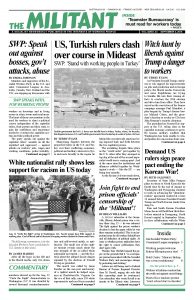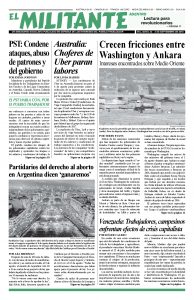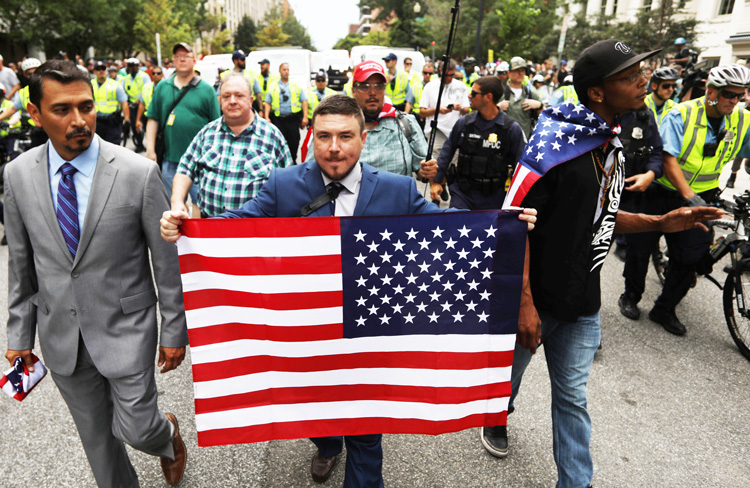The following commentary is by the Socialist Workers Party candidate for U.S. Senate in Maryland.
After all the hype on the left and in the liberal media, only two dozen marchers showed up for the Aug. 12 “Unite the Right” demonstration in Washington, D.C. It was dwarfed by several thousand counterdemonstrators and self-avowed antifa, or antifascists. The small size of the rightist turnout reveals much about the true strength of the so-called white nationalist movement — and the hysteria about the alleged fascist danger signaled by the election of Donald Trump as president.
The march was called by Jason Kessler on the one-year anniversary of a rightist march he helped organize in Charlottesville, Virginia. On the eve of that rally, some 250 white supremacists and neo-Nazis marched with torches across the University of Virginia campus in Charlottesville, chanting, “White lives matter”; “Blood and soil,” a slogan used by Adolf Hitler to build the Nazi party in Germany; and “Jews will not replace us.”
The following day some of those ultra-rightist thugs joined Kessler’s “Unite the Right” rally of some 500. Rightist thugs and dozens of antifa combatants — some armed on both sides — engaged in bloody skirmishes. After the cops called off the rally, one of the neo-Nazis turned his car into a weapon and drove into a group of counterprotesters, killing Heather Heyer and injuring 19 others.
Kessler said the goal of the anniversary action was to stand up for the rights of oppressed white people and for free speech. Kessler denied he is a white supremacist and said neo-Nazis were disinvited from the rally. He did, however, invite the participation of people associated with the KKK, Holocaust deniers, self-proclaimed Jew-haters and other open racists.
The small size of the rally reflects the real decline in racism in the U.S. following the victories won by the massive Black rights movement during the 1940s, ’50s, ’60s and ’70s that changed the thinking and attitudes of tens of millions. These working-class struggles made the expression of openly racist ideas repugnant to most working people.
This fact was totally missing in the over-the-top response given to the announcement of the demonstration by the bourgeois media, local governments and the left.
In Virginia, Gov. Ralph Northam and the city of Charlottesville declared a state of emergency for Aug. 12 and said it could possibly be extended for a month, earmarking $2 million for cop mobilization. In the end no rightist demonstration took place there.
The Washington, D.C., government says it spent $2.6 million on the massive police response. Both the National Park Service and some in the D.C. government once again floated the idea that demonstrators should have to cover the cost of policing their protests — which would be a severe restriction on the right to demonstrate in the nation’s capital.
On the middle-class left, a number of groups issued semi-hysterical flyers and announcements on the internet claiming the alt-right march threatened the imminent imposition of fascism. They claimed virulent white supremacist attitudes are on the rise in the working class, reflected in Trump’s election to the presidency.
“While the openly Nazi and white supremacist forces may now be afraid to take to the streets, that doesn’t mean they have been defeated,” the Workers World Party said in their paper, counseling readers not to become complacent because of the small size of the rightist action. “On the contrary, they are not only in their klaverns and death cults, but many wear the uniforms of local police and Border Patrol. … And the far-right Trump appointees now in charge of so many federal agencies,” they opined, “must be fought as they push the government even further to the right.”
This and similar articles on the website of the Party for Socialism and Liberation and other left groups paint a picture of a rising fascist threat in the U.S. that they associate with Trump. The fact is there is no growing fascist movement in the U.S. today. It isn’t that they were scared off by Workers World or the PSL. Self-proclaimed fascists have zero influence in the working class.
The outlook of these left organizations mimics the “resistance” to Trump spread daily by the editors of the Washington Post, New York Times and other liberal organs oriented to winning a Democratic majority in Congress in the 2018 elections and impeaching or indicting the president.
The capitalist rulers today have no need to grow a fascist movement. When they do, it will be because millions of workers are in the streets and their rule is threatened. Whipping up hysteria that this is the reality today can only disorient and disarm workers.
When the time comes, small bands of leftists and antifa will be of no help in taking on fascist thuggery that’s backed by the capitalist class. Only the working-class in their millions can organize an effective fight against a real fascist threat, through a disciplined and organized workers defense guard built through the unions. There are examples of this in past struggles by the U.S. working class that our class can learn from. One place to look is in Teamster Politics by Farrell Dobbs, where this leader of the Teamsters over-the-road Midwest organizing drive and the Socialist Workers Party explains how the union turned back the fascist Silver Shirts in the 1930s.
The Socialist Workers Party candidates explain that painting a false picture of an impending fascist threat and anti-Trump hysteria is dangerous for working people. The rulers use this to promote restrictions on political rights — like the idea of making you pay for cops to “police” your demonstration.
Every move that closes down political space for workers to discuss and debate a way forward — like preventing speakers from have a meeting on campus because you dislike their views — is an obstacle.


